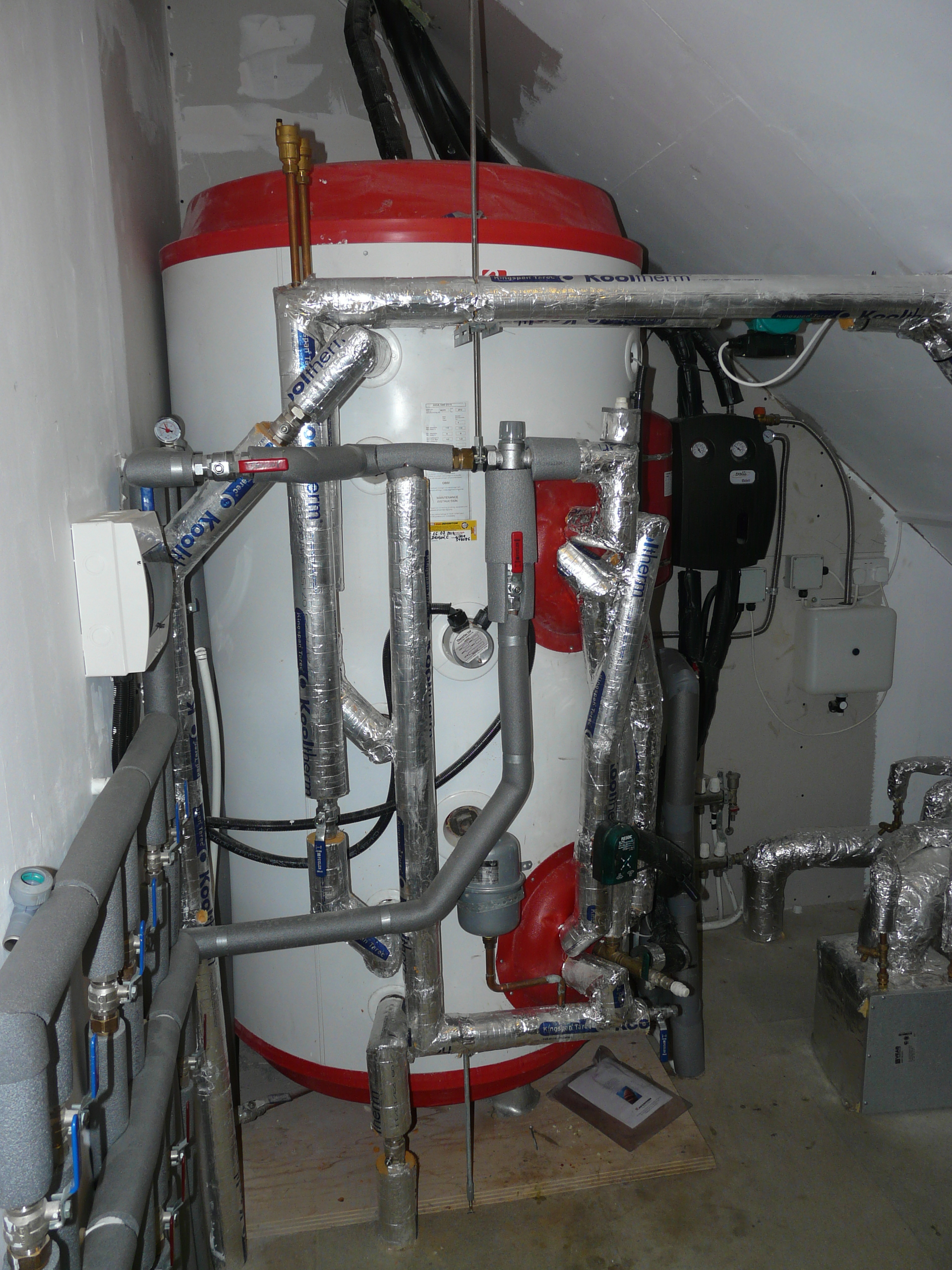
The Akvaterm thermal store – 1,000 litres
The thermal store, mentioned several times in the main pages, is a variant on a Akvaterm Solar 1000 litre tank.
This huge (by most standards), well insulated tank is the core of the house’s thermal management. There are three possible heat inputs to it and four possible heat outputs from it. The main input is the feed from the solar panels – 9m² gross, 8m² actual – which is arranged to heat the top of the tank first if need be and then the lower part only when the upper part is “satisfied” – the temperature is high enough. (The controller is a bit cleverer than this but the concept is right.) For the dark days – late autumn, winter and early spring (and, this year (2013), May!) the second heat input is from the log burner, a Woodfire F12, which puts most of its output into water, not the room. And finally, for when we are too tired, frail, ill or whatever, there’s an immersion heater!
The four outputs are domestic hot water (DHW), air heating, underfloor heating and the towel rails.
For DHW, the incoming mains supply is connected to a coil in the bottom of the tank, which preheats the water with any heat that may be there, and is then passed through a second coil in the top part of the tank. The output is then mixed with cold water to supply the house at a safe temperature. The tank has been positioned within the house to minimise the lengths of the pipe-runs to kitchen and bathrooms (dead legs). I’d argue that the most important of these is the run to the kitchen because it gets used most often. The pipes are either well insulated or run within the walls, which are filled with Warmcel – and are therefore well insulated!
For air heating, an output is taken to the two air duct heaters – water matrices – which heat the incoming air. The main heater (called a battery, I don’t know why) heats the air to all the house except the sitting room and dining room. This is because it is probable that, when the house needs heat in this way, the stove is being used – which will heat these two rooms directly anyway. The second battery heats the air being supplied to the sitting and dining/living rooms only for the occasions when the log burner is not in use, and when the thermostat calls for it. We’ve found that we had to replace the wall mounted thermostat in the stairwell with a wireless version and the sender – the thermometer bit – is in the downstairs bedroom. This was because the stairwell tended to be cooler than elsewhere and the heating was on unnecessarily.
Underfloor heating is installed in the north of the house, which will not receive solar gain. It’s buried deep in the foundation slab, so the response time will be slow and the amount of heat that can be stored is high. Experience will show the best way to use this, but it seems likely that when the log burner is brought into use, it could be sensible to heat up not just the thermal store but also to push a lot of heat into the slab via the underfloor heating. This will help keep the house warm for longer over a period of dark, cold weather and may reduce how frequently the stove needs lighting. Experience – in the winter of 2012/3 and again in 2013/4 – has shown that we do not use the UFH – the duct heaters are entirely sufficient on their own. Our opinion is that it would take a great deal of wood and quite a long time (you have to be there to feed the log burner, of course) to warm up the floor because of the thickness of the slab and, if the following day was then warm, the house would be too hot and we would have wasted the wood. If/when we replace this with a pellet burner which looks after itself then we might operate differently.
There will be a towel rail – actually a small conventional radiator – in each bathroom/ensuite. Experience in our old house has shown that the times when towels need drying is in summer, when there is no heating. In winter, the bathroom radiators/towel rails are on with the central heating and the towels get dried – but in the summer they do not. With the mechanical ventilation system with heat recovery (MVHR), the air in the house is always moving and will also tend to be dry, so it is possible, even probable that towels will dry anyway – but, just in case, a small radiator under the towel rails will deal with this potential problem. “Proper” towel rails have not been used because a) they will put too much heat into the house and b) they are expensive. Here again, experience has now (April 2014) shown that the towels dry very well in both summer and winter and we have never yet had to use these little radiators.
How much heat does the thermal store hold? Well, water at less than 40C is not much use and let us assume that the store gets up to 80C. So, in round figures, there are 1,000 litres (= 1,000,000 grammes) of water with a usable temperature difference of 80-40 = 40 centigrade degrees. It takes 1 calorie to heat 1 gram of water 1 degree centigrade. Each calorie is 4.12 joules or watt-seconds. So the store holds 40,000,000 x 4.18 watt-seconds = 46.4 kilowatt hours. Roughly. If I’ve got this wrong I’m sure someone will tell me!
